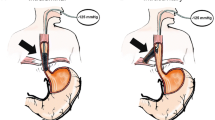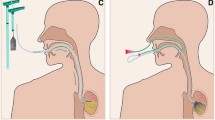Abstract
Background
Anastomotic insufficiency in esophageal anastomosis and esophageal defects of other etiology are very severe complications. For anastomotic insufficiency in the rectum, endoscopic vacuum therapy has already been used successfully. The authors used vacuum therapy for anastomotic defects and other lesions of the esophagus.
Methods
Between November 2006 and September 2009, 10 patients (5 men and 5 women, ages 46–82 years) were treated with endoscopic vacuum sponge therapy for anastomotic insufficiency secondary to esophagectomy or gastrectomy (n = 5), iatrogenic esophageal perforation (n = 2), esophageal wall necrosis (n = 1), Boerhaave’s syndrome (n = 1), and perforation of esophageal cancer (n = 1).
Results
After one to seven changes of the sponge at intervals of 2–7 days and a mean therapy duration of 12 days, the defects were healed in all the surviving patients. During treatment, the patients were fed via an intestinal tube or percutaneous endoscopic gastrostomy (PEG), or enterally past the sponge. One patient died of intercurrent severe colitis. In three cases, a revision laparotomy was necessary at the beginning of treatment. No postinterventional stricture or functional relevant scar formation was observed during a follow-up period of 10–380 days after termination of the vacuum therapy.
Conclusion
Esophageal anastomotic insufficiency and esophageal wall defects of other causes can be treated successfully with endoscopic vacuum sponge therapy.

Similar content being viewed by others
References
Alanezi K, Urschel JD (2004) Mortality secondary to esophageal anastomotic leak. Ann Thorac Cardiovasc Surg 10:71–75
Papachristou DN, Fortner JG (1979) Anastomotic failure complicating total gastrectomy and esophagogastrectomy for cancer of the stomach. Am J Surg 138:399–402
Urschel JD (1995) Esophagogastrostomy anastomotic leaks complicating esophagectomy: a review. Am J Surg 169:634–640
Crestanello JA, Deschamps C, Cassivi SD, Nichols FC, Allen MS, Schleck C, Pairolero PC (2005) Selective management of intrathoracic anastomotic leak after esophagectomy. J Thorac Cardiovasc Surg 129:254–260
Huttl TP, Wichmann MW, Geiger TK, Schildberg FW, Furst H (2002) Techniques and results of esophageal cancer surgery in Germany. Langenbecks Arch Surg 387:125–129
Lang H, Piso P, Stukenborg C, Raab R, Jahne J (2000) Management and results of proximal anastomotic leaks in a series of 1,114 total gastrectomies for gastric carcinoma. Eur J Surg Oncol 26:168–171
Page RD, Shackcloth MJ, Russell GN, Pennefather SH (2005) Surgical treatment of anastomotic leaks after oesophagectomy. Eur J Cardiothorac Surg 27:337–343
Budisin N, Budisin E, Golubovic A (2001) Early complications following total gastrectomy for gastric cancer. J Surg Oncol 77:35–41
Junemann-Ramirez M, Awan MY, Khan ZM, Rahamim JS (2005) Anastomotic leakage postesophagogastrectomy for esophageal carcinoma: retrospective analysis of predictive factors, management and influence on long-term survival in a high volume centre. Eur J Cardiothorac Surg 27:3–7
Bruckner M, Grimm H, Nam VC, Soehendra N (1991) Experience with a transnasally fixed endoprosthesis for treating esophageal anastomotic leakage. Surg Endosc 5:185–188
Doniec JM, Schniewind B, Kahlke V, Kremer B, Grimm H (2003) Therapy of anastomotic leaks by means of covered self-expanding metallic stents after esophagogastrectomy. Endoscopy 35:652–658
Roy-Choudhury SH, Nicholson AA, Wedgwood KR, Mannion RA, Sedman PC, Royston CM, Breen DJ (2001) Symptomatic malignant gastroesophageal anastomotic leak: management with covered metallic esophageal stents. AJR Am J Roentgenol 176:161–165
Schmidt H, Manegold BC, Stüker D, Grund KE (2001) Anastomotic insufficiencies of the esophagus: early surgical endoscopy and endoscopic therapy. Kongressbd Dtsch Ges Chir Kongr 118:278–281
Hunerbein M, Stroszczynski C, Moesta KT, Schlag PM (2004) Treatment of thoracic anastomotic leaks after esophagectomy with self-expanding plastic stents. Ann Surg 240:801–807
Langer FB, Wenzl E, Prager G, Salat A, Miholic J, Mang T, Zacherl J (2005) Management of postoperative esophageal leaks with the Polyflex self-expanding covered plastic stent. Ann Thorac Surg 79:398–403
Schubert D, Scheidbach H, Kuhn R, Wex C, Weiss G, Eder F, Lippert H, Pross M (2005) Endoscopic treatment of thoracic esophageal anastomotic leaks by using silicone-covered, self-expanding polyester stents. Gastrointest Endosc 61:891–896
Griffin SM, Lamb PJ, Dresner SM, Richardson DL, Hayes N (2001) Diagnosis and management of a mediastinal leak following radical oesophagectomy. Br J Surg 88:1346–1351
Schubert D, Pross M, Nestler G, Ptok H, Scheidbach H, Fahlke J, Lippert H (2006) Endoscopic treatment of mediastinal anastomotic leaks. Zentralbl Chir 131:369–375
Pross M, Manger T, Reinheckel T, Mirow L, Kunz D, Lippert H (2000) Endoscopic treatment of clinically symptomatic leaks of thoracic esophageal anastomoses. Gastrointest Endosc 51:73–76
Truong S, Bohm G, Klinge U, Stumpf M, Schumpelick V (2004) Results after endoscopic treatment of postoperative upper gastrointestinal fistulas and leaks using combined Vicryl plug and fibrin glue. Surg Endosc 18:1105–1108
Argenta LC, Morykwas MJ (1997) Vacuum-assisted closure: a new method for wound control and treatment: clinical experience. Ann Plast Surg 38:563–576
Weidenhagen R, Gruetzner KU, Wiecken T, Spelsberg F, Jauch KW (2008) Endoscopic vacuum-assisted closure of anastomotic leakage following anterior resection of the rectum: a new method. Surg Endosc 22:1818–1825
Loske G, Muller C (2009) Vacuum therapy of an esophageal anastomotic leakage: a case report. Zentralbl Chir 134:267–270
Vallbohmer D, Holscher AH, Holscher M, Bludau M, Gutschow C, Stippel D, Bollschweiler E, Schroder W (2009) Options in the management of esophageal perforation: analysis over a 12-year period. Dis Esophagus. [Epub ahead of print]
Disclosures
Dr. Gunnar Loske and Prof. Dr. Mueller received honoraria for organizing and performing a workshop dealing with vacuum therapy of anastomotic dehiscence following resections in the upper and lower gastro-intestinal tract by BBD Aesculap. T. Schorsch declares no conflict of interest.
Author information
Authors and Affiliations
Corresponding author
Rights and permissions
About this article
Cite this article
Loske, G., Schorsch, T. & Müller, C. Endoscopic vacuum sponge therapy for esophageal defects. Surg Endosc 24, 2531–2535 (2010). https://doi.org/10.1007/s00464-010-0998-x
Received:
Accepted:
Published:
Issue Date:
DOI: https://doi.org/10.1007/s00464-010-0998-x




